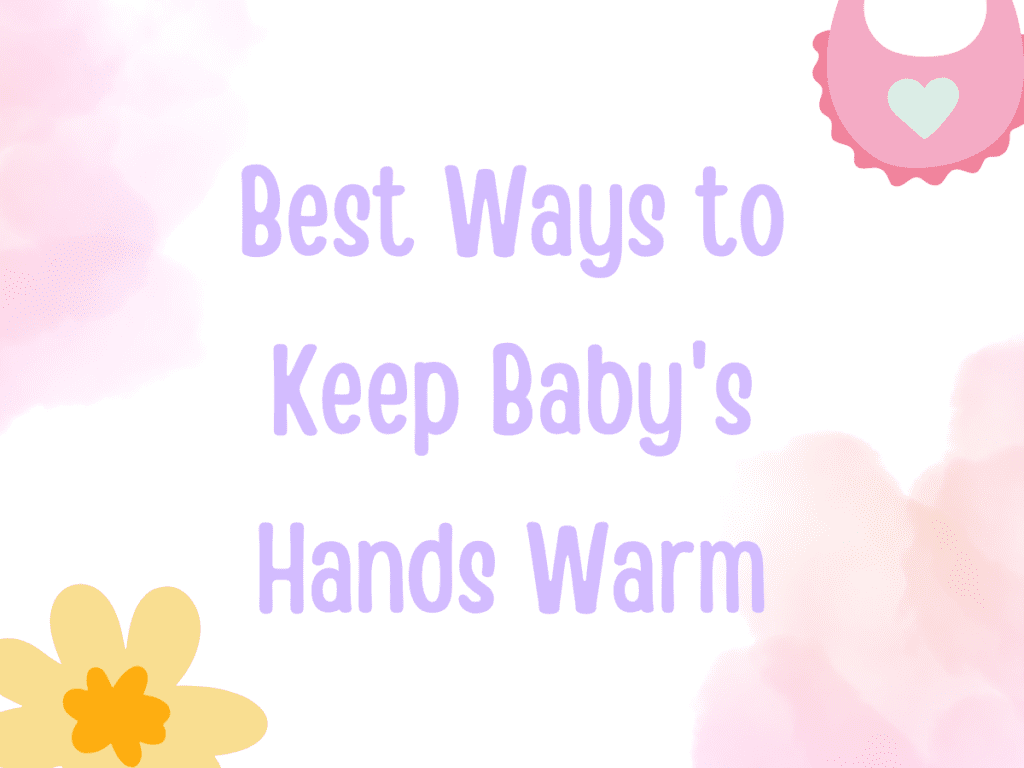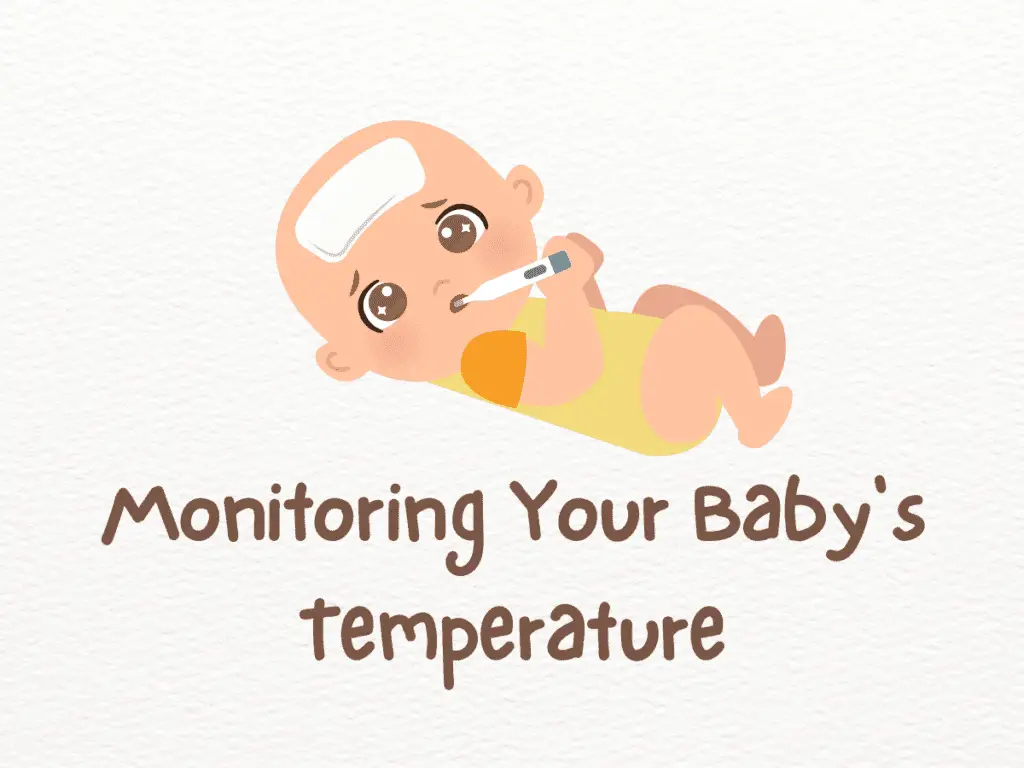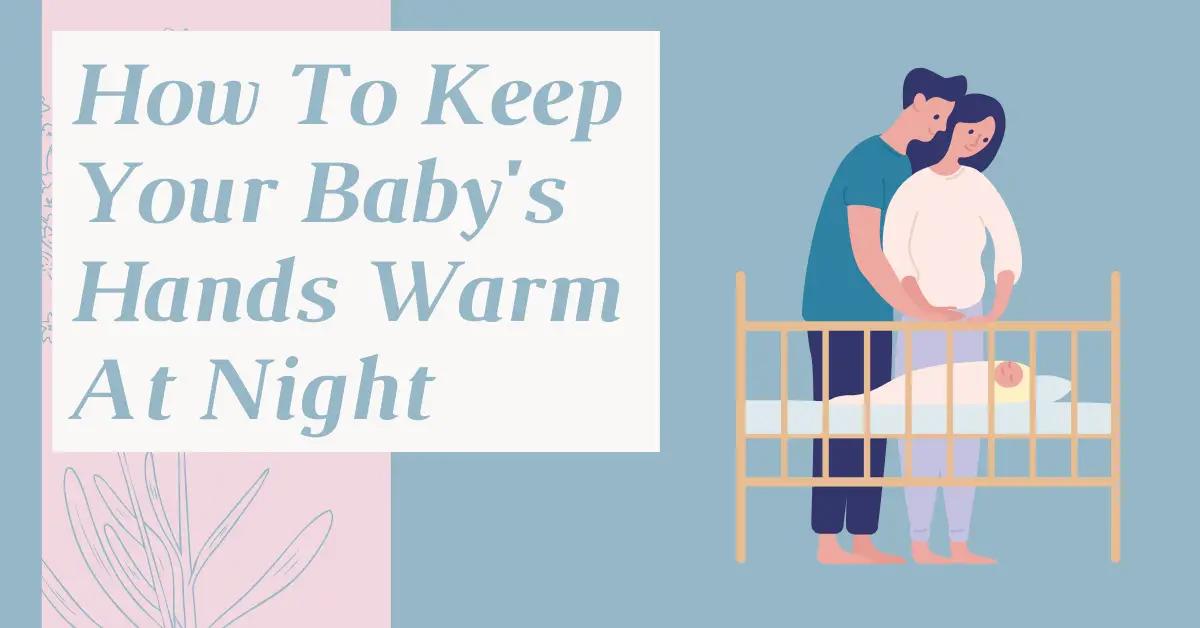Every parent knows that comforting warmth that floods over you when you gently hold your baby’s little hands. But on some nights, particularly when the chill of the colder winter months sets in, these delicate fingers may feel a tad colder than expected. It’s a concern many new parents share – why are my baby’s hands cold at night? and is it something to worry about?
The importance of maintaining the right temperature for your baby cannot be overstated. Cold hands can be a mere reflection of the environment, but they might also point towards the room’s temperature not being optimal for your little one’s comfort and safety. As we delve deeper into this topic, we’ll explore both the science behind those chilly fingers and practical solutions to ensure those tiny hands stay warm and cozy all night long. Whether you’re navigating the challenges of parenthood for the first time or seeking reassurance for subsequent children, this guide is tailored for you. Let’s embark on this journey to ensure the warmth and safety of your baby’s precious hands.
Disclaimer
This article is intended to provide general information and tips on keeping babies’ hands warm at night. It is not a substitute for professional medical advice, diagnosis, or treatment. Always consult with a pediatrician or other qualified healthcare professional regarding any concerns about your baby’s health and well-being. While every effort has been made to ensure the accuracy and reliability of the information presented, neither the author nor the publisher can assume responsibility for any errors or omissions or for any outcomes related to the use of this content. Always prioritize safety and follow the guidelines provided by trusted health organizations.
Understanding Why Baby’s Hands Get Cold
When those tiny fingers feel icy, it’s not uncommon for parents to immediately jump to concern. However, it’s essential to grasp the physiological reasons behind this phenomenon to respond effectively and with understanding.
- Baby’s Skin and Blood Flow: Babies, especially newborns, have a circulation system that’s still developing. As a result, their blood flow prioritizes essential organs such as the heart and brain. This means extremities like hands (and even feet) may receive less blood flow, making them cooler to the touch.
- Core vs. Extremity Temperature: One of the fascinating aspects of the human body is its ability to regulate core body temperature. For babies, while their hands might feel cold, it doesn’t necessarily mean their core body temperature is low. The body ensures that vital organs maintain an appropriate temperature, even if it comes at the cost of cooler extremities.
- Environmental Influences: Naturally, during the winter season or colder months, the surrounding environment can make a significant impact. Drafty windows, cold climate, or a drop in room temperature during the night can lead to your baby’s hands feeling cold. This is especially pronounced if the baby’s crib is positioned near air vents or areas with lot of cold air flow.
It’s essential to remember that cold hands aren’t always a cause for alarm. Often, they’re a part of a baby’s natural physiological response to their environment. However, knowing when and how to intervene is crucial. As we continue, we’ll explore the best practices suggested by professionals and learn to differentiate between normal cold hands and situations that might need more attention.

The American Academy of Pediatrics’ Safe Sleep Guidelines
Ensuring your baby’s safety while they sleep is paramount. This is why it’s essential to turn to trusted sources, like the American Academy of Pediatrics (AAP), when looking for guidance. The AAP provides several recommendations about creating a safe sleep environment, some of which also affect how warm or cold your baby feels at night.
- Risk of Sudden Infant Death Syndrome (SIDS): One of the leading concerns when discussing baby sleep is the risk of SIDS. While the exact cause remains elusive, certain factors can elevate the risk. The AAP’s safe sleep guidelines are designed to minimize these risks.
- Safe Sleep Environment: According to the AAP, the ideal sleep setting for a baby is a firm mattress in a safety-approved crib or bassinet. Loose objects, including soft toys, pillows, and even loose blankets, should be avoided as they pose a potential suffocation risk. While you might be tempted to throw in an extra blanket for warmth, this can be risky.
- Room Temperature and Attire: The AAP suggests that babies should wear enough clothing to keep them warm without needing blankets. A wearable blanket or a sleep sack can provide the necessary warmth without the associated risks. Moreover, the ideal room temperature for a baby’s comfort and safety is typically between 68 and 72 degrees Fahrenheit.
- Avoiding Overheating: Just as cold hands can be a concern, so can an overly warm baby. It’s a good idea to touch the baby’s chest or back of their neck to get an accurate sense of their body temperature. Overheating can be a risk factor for SIDS, so ensure the baby’s head remains uncovered, and they aren’t swaddled too tightly.
- Positioning: Always ensure your baby sleeps on their back. This position not only reduces the risk of SIDS but also ensures better circulation, potentially helping with the temperature regulation of extremities like hands.
- Regular Checks: While it’s essential to let babies have uninterrupted sleep, occasional checks during colder nights can offer peace of mind. Feel the baby’s chest or back of the neck to ensure they’re at a comfortable temperature.
Understanding and implementing these guidelines can play a pivotal role in ensuring your baby’s safety and comfort throughout the night. While cold hands might sometimes be a concern, following best practices will often provide the reassurance and solutions parents seek.

Best Ways to Keep Baby’s Hands Warm
While understanding why a baby’s hands can get cold is vital, the primary concern for most parents is how to ensure those little fingers stay warm and cozy throughout the night. Here are some tested and trusted methods:
- Wearable Blanket: Often touted as the best way to provide extra warmth without the risks associated with loose blankets, a wearable blanket envelops the baby in a cocoon of warmth. These are especially useful during the winter months and colder nights, giving that extra layer of comfort.
- Long Sleeves with Mitten Cuffs: A practical solution is dressing your baby in long sleeves that come with mitten cuffs. These cuffs, which can fold over the baby’s hands, serve a dual purpose: they keep the baby’s hands warm and prevent them from scratching themselves with their nails.
- Baby Sleeping Bag: Similar to the wearable blanket, a baby sleeping bag provides warmth without the dangers of loose blankets. These sleeping bags, which come in various materials and tog ratings (a measure of the product’s thermal resistance), allow parents to choose the right warmth level based on the room’s temperature.
- Polyester Fleece Sleep Sacks: Particularly useful for the winter season, these sleep sacks provide a higher degree of warmth. They are a great option to ensure that your baby remains warm even when the temperature dips significantly.
- Maintaining Ideal Room Temperature: While addressing the baby’s attire is essential, ensuring the room is at a comfortable temperature is equally crucial. Use a room thermometer to monitor and maintain the temperature between 68 and 72 degrees Fahrenheit.
- Hot Water Bottle: This is an age-old remedy many parents swear by. However, it’s essential to use it safely. The hot water bottle can be placed in the crib to warm it up before bedtime, but always ensure it’s removed before placing the baby in the crib.
- Avoid Drafty Areas: Ensure the baby’s crib is away from windows, doors, or air vents, which might let in cold drafts. If necessary, use draft protectors or move the crib to a warmer spot in the room.
- Layering: Depending on how cold the night is, consider adding an extra layer of clothing. However, always ensure the baby doesn’t overheat. An additional layer might be a thin vest under a sleep suit.
Parents often wonder about the best option for their baby. The good news is that with a mix of these strategies, you can find a combination that best suits your child’s needs, ensuring those little hands remain warm and the sleep environment stays safe.
What to Avoid in Baby’s Crib
As much as it’s essential to know what measures can help in keeping your baby warm, it’s equally crucial to be aware of practices and items to avoid. These could pose potential risks to the baby or be counterproductive to your warming efforts.
- Loose Blankets: Even though your instinct might be to tuck your baby under a warm blanket, loose blankets in the crib can pose a suffocation risk. The American Academy of Pediatrics advises against using them, especially for babies under 12 months.
- Electric Blanket and Heating Pad: It might seem like a convenient way to provide warmth, but electric blankets or heating pads can be risky. They can cause burns, overheating, or even potential electrical hazards. Moreover, the consistent temperature they provide might lead to overheating for your baby.
- Space Heaters: If the room’s temperature is challenging to maintain, some might consider using a space heater. However, these need to be used with extreme caution. They can become fire hazards, and if they tip over, can pose a direct risk to the baby. Additionally, they can make the room too dry or too warm rapidly.
- Stuffed Animals and Soft Toys: While these might seem like they provide comfort and potential warmth, they are best kept out of a baby’s crib. They can lead to potential suffocation risks, and babies might not always benefit from the perceived warmth they offer.
- Pillows: Babies don’t need pillows, and having them in the crib can lead to potential suffocation risks. It’s best to keep the crib as minimalistic as possible.
- Drafty Windows: While already touched upon, it’s worth reiterating that drafty windows can be a significant source of cold air. Ensuring that windows are sealed or using thicker curtains can be beneficial.
- Overdressing: While layering is a recommended strategy, there is such a thing as too many layers. Overdressing can cause the baby to overheat, which can be just as risky as being too cold.
The key takeaway for new parents is the mantra, “less is more.” The simpler the baby’s sleep environment, the easier it is to control, monitor, and ensure it’s safe. Balancing warmth and safety is the goal, and by avoiding certain items and practices, you are well on your way to achieving it.

Monitoring Your Baby’s Temperature
While we’ve armed ourselves with tools and methods to ensure our babies remain warm, understanding how to monitor and interpret your baby’s body temperature becomes pivotal. So, how can you ascertain if your baby is comfortable, too cold, or even too warm?
- Touch the Chest or Back of the Neck: Instead of solely relying on the temperature of the baby’s hands or feet, the baby’s chest or the back of their neck offers a more accurate indication of their core temperature. If they feel sweaty, they might be overheating. If they feel too cold, they may need additional warmth.
- Look for Signs of Discomfort: A baby that’s too cold or too warm might be restless. Unusual crying patterns, especially in the middle of the night, could indicate temperature discomfort.
- Check the Room Thermometer: While baby’s body signs are a direct indicator, don’t forget to periodically glance at the room thermometer. If it’s showing a temperature below 68 degrees Fahrenheit or above 72 degrees, adjustments might be necessary.
- Red Flags: Cold, blotchy, or blue-tinged skin can indicate that your baby is too cold. Conversely, flushed cheeks, heat rash, or damp hair could indicate overheating.
- Maintain Regular Monitoring: Especially during colder months or sudden weather changes, it’s a good idea to check on the baby multiple times throughout the night. However, ensure your checks don’t disrupt their sleep cycle.
- Keep Track of General Behavior: If your baby seems lethargic, unusually sleepy, or shows any signs of rapid breathing, it’s crucial to seek medical advice. While these symptoms might not always relate to temperature, it’s essential to rule out any related concerns.
- Seeking Medical Attention: If ever in doubt, don’t hesitate to reach out to a pediatrician. If your baby’s cold hands are accompanied by other concerning symptoms or if you’re unsure about their body temperature, seeking professional medical advice is always the best option.
In the journey of parenting, instincts often play a vital role. Trust your gut feelings but also arm yourself with the knowledge to differentiate between typical behaviours and potential warning signs. Ensuring your baby’s comfort and safety is a continuous process, but with keen observation and prompt action, you can navigate the challenges effectively.
Additional Tips and Common Concerns
The realm of baby care, especially when it comes to keeping them warm, doesn’t end with the basics. There are often nuances and additional aspects that new parents might stumble upon or be curious about. Let’s address some common concerns and share more handy tips:
- Cold Hands but Warm Body: It’s quite typical for young babies to have cold hands even if their core body temperature is just right. Babies have a developing circulatory system, leading to less blood flow to their extremities. Always rely on the baby’s chest or neck for a more accurate temperature reading.
- Polyester Fleece vs. Cotton: When considering sleep sacks or wearable blankets, you might wonder which material is better. Polyester fleece offers more warmth, making it suitable for colder climates or winter season. Cotton, however, is breathable and preferable for moderate temperatures.
- The Tog Rating System: If you’re buying sleepwear or sleep sacks for your baby, you might come across the ‘tog’ rating. It’s a measure of warmth, with a higher tog meaning more warmth. It’s a great way to select sleepwear based on the climate or season.
- Ventilation is Key: Even in cold weather, it’s a good idea to ensure the baby’s room is well-ventilated. Fresh air helps in maintaining good air quality and reducing the risk of SIDS.
- Consistency in Sleep Environment: As much as possible, try to maintain a consistent sleep environment. Sudden changes in room temperature or sleepwear can disrupt a baby’s sleep pattern.
- Draft Protectors and Humidifiers: If you’re battling with drafty windows, consider draft protectors. During winter, heaters can make the air dry, which might affect your baby’s skin and respiratory system. A humidifier can help maintain moisture in the room.
- Layering Principle: If you’re unsure about how many layers your baby needs, a good rule of thumb is to dress them in one more layer than you would wear to be comfortable.
- Affiliate Links and Recommendations: While searching for products or recommendations online, you might come across affiliate links. Always read multiple reviews and consult trusted sources before making a purchase.
Navigating the first few months and even years of parenthood can be daunting. With every concern, there’s a wealth of information, advice, and often a handful of myths. The most important thing is to be informed, rely on trusted sources, and always prioritize your baby’s safety and comfort. Your journey might be filled with trials and errors, but every step will bring more confidence and assurance.
Final Thoughts On Keeping Your Baby’s Hands Warm At Night
Ensuring the warmth of our little ones, especially during cold nights, is an endeavour every parent embarks upon with great dedication. However, the journey often intertwines with concerns, doubts, and the pursuit of the best practices. Keeping a baby warm isn’t just about piling on layers or turning up the heat. It’s a delicate balance between providing comfort, ensuring safety, and understanding the unique needs of your child.
Remember:
- Trust Your Instincts: As parents, your instincts about your baby’s well-being are often spot on. Use the information provided, but always listen to your gut feelings.
- Stay Informed: Keeping abreast of guidelines from trusted organizations, like the American Academy of Pediatrics, can provide clarity and confidence in your decisions.
- Safety First: While warmth is crucial, safety should never be compromised. Whether it’s avoiding loose blankets in the crib or being wary of potential suffocation risks, always prioritize safety.
- Constant Monitoring: Babies are continually growing and changing. What worked last month might not be suitable now. Regularly monitor your baby’s comfort and adjust accordingly.
- Seek Support: The journey of parenting isn’t one to be walked alone. Whether it’s seeking advice from pediatricians, joining parent groups, or simply talking to friends and family, always remember that support is invaluable.
In the end, the goal is to ensure our babies sleep soundly, comfortably, and safely. As you move forward, equipped with knowledge, insights, and a dash of parental instinct, the cold nights will seem a tad bit warmer, and the challenges a little less daunting. Here’s to warm, cozy, and safe nights for your little one!
Frequently Asked Questions (FAQs) About Keeping Baby Hands Warm
To further assist parents and caregivers, we’ve compiled a list of common questions about ensuring babies stay warm, especially during the night. Let’s address these concerns:
Why are my baby’s hands and feet always cold?
This is often due to their developing circulatory system. While the core body temperature may be perfect, their extremities, like hands and feet, can feel cold. Always check the baby’s chest or back of the neck for a more accurate reading.
Is it normal for my baby to sweat while sleeping?
Yes, some babies might sweat during sleep, especially around the head. However, excessive sweating could indicate that they are overdressed or the room temperature is too high.
How can I ensure my baby doesn’t overheat?
Dress the baby in breathable fabrics, maintain an ideal room temperature (typically between 68-72 degrees Fahrenheit), and regularly check the baby’s neck or chest to ensure they’re not too warm.
What if my baby has a fever but cold hands?
This can be concerning. A fever indicates an elevated body temperature, but cold hands might suggest poor blood circulation. In such cases, always consult a pediatrician.
Can I use mittens to keep my baby’s hands warm at night?
While mittens can provide warmth, they can also prevent babies from using their hands to soothe themselves. If you opt for mittens, ensure they’re secure and won’t come off during sleep, posing a potential risk.
How will I know if my baby is too cold at night?
Signs can include constant fussiness, cold chest or back of the neck, and unusually cold extremities. It’s always good to monitor and make adjustments as necessary.
Is it okay to use a hat to keep my baby warm at night?
It’s generally advised against using hats indoors as babies regulate their temperature through their head. Wearing a hat can lead to overheating.
How often should I change my baby’s clothing at night?
Unless the baby has soiled their clothing, there’s no strict rule. However, if the room temperature drops or rises significantly during the night, adjusting their clothing to accommodate these changes might be necessary.
Can I use a fan in my baby’s room during colder months?
Yes, a fan can promote ventilation and reduce the risk of SIDS. Ensure it’s on a low setting and not blowing directly on the baby.
Should I wake my baby if I feel they are too cold or too warm?
If minor adjustments like adding or removing a layer can be done without waking them, it’s preferable. However, if there’s a significant concern about their comfort or safety, it’s better to address the issue, even if it means briefly waking them.
The key is to be observant, proactive, and responsive to the baby’s needs. When in doubt, always lean on the side of caution and seek advice from trusted sources or professionals.

